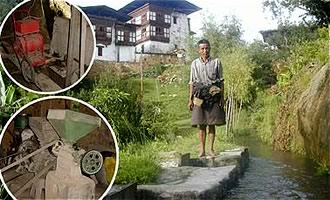|
Ap
Namgay Wangchuk: A village genius |
 |
Bhutan People |
|
 |
Bhutan Information |
|
|
 |
|
A
farmer experiments with technology |
 |
| Ap Namgay Wangchuk of Shingchug village, Punakha, and (inset) some of his
innovations |
| A
genius is not necessarily a product of education. This rings true for Ap
Namgay Wangchuk, a farmer from Shingchug village in Punakha, who
at the age of 50 would put Thomas Elva Edison, the father of many inventions,
to envy. Tall and bare-footed, sporting short grey hair and moustache,
Ap Namgay has over the years become more of an inventor than a
farmer. |
|
He has devised a way of using water from the irrigation canal
to run three devices: flour-grinder, rice huller and oil expeller. Not
only that he generates his own electricity from it making him the only
farmer to do so in Bhutan.
Inside
a makeshift hut, Ap Namgay's explanations of each operation is as
compelling as his ingenuity to experiment with technology, a subject alien
to farmers. All operations are hinged on the laws of physics.
For
water flow, he uses the village's irrigation canal that passes by his
house. Dam as such is not visible but he uses a small opening blocked
by a wooden plank placed alongside it. When the plank is pulled out
water rushes down through a steep hollow log. Six meters below the
force of water spins a home-made turbine made of several wood planks
tied around with strings. This in turn spins the big wheel inside
the hut, the cumulative effect being the spinning of various other
wheels attached to the rice-grinder, flour huller and the oil expeller
with belts while at the same time producing electricity - all simultaneously.
A "Kuboto dynamo", actually used for power tiller, is used to generate
electricity. Electricity is yet to reach the village. But Ap Namgay has
no problems: for the past seven years he has had enough to light
about 14 bulbs every night.
Among
the many spin-offs, which his innovations produce, is the increase
in income. The rice and the flourmills were started way back in 1985
using the water and since then he never had to use fossil fuel.
"I saved a lot of money on that," says Ap Namgay. Today Ap Namgay
makes more than Nu 15,000 a year with fees collected from local farmers
for milling charges. Last year he milled about 3.8 metric tonnes
of rice and had 9.5 metric tonnes of oil extracted. Poor farmers,
who cannot afford mills, are reaping the benefits. Some from as far
as the Zomi geog come to him. "I charge half the price for milling and
oil extraction than those charged by mills run on conventional fossil
fuel," he says. Besides, he has also bought a power tiller which
he uses for his paddy fields. He grows rice, wheat, and mustard seeds.
With
a disarming smile which seems a natural extension of himself, Ap
Namgay tells a story of how he stumbled upon the whole idea. In 1984,
during one of the farmer study tours, he visited Chukha hydroproject corporation.
"There I saw the force of water turning the turbine and producing
electricity." He visited various other industries and agro-processing
units. "It struck me then that the fundamental idea behind any mechanization
is being able to turn and rotate wheels," he says. "I also
saw that engines and motors are actually used to turn these wheels,
which in turn are attached to various machines or parts to carry
out a specific task." He was in his mid-twenties then.
After
the tour, Ap Namgay was determined to try out what he saw. He immediately
bought machinery parts like wheel, axle, belts, and a Kuboto dynamo
from the Bajo agriculture machinery units and some from India. He
invested about Nu 0.1 million in the project. With some parts carved
from wood like the turbine, wheel for resting the belt and a conduit
for water flow, Ap Namgay began his maiden experiment. Nobody helped
him. "It was an instant success," he says. A researcher in
Bajo agriculture research center says he has never seen a man, leave
alone a farmer, who has quicker relationship between his eyes, brains
and hands.
Agriculture officials there were not aware of Ap Namgay's
innovations until one stumbled on him at his house "one fine day".
They plan to replicate Ap Namgay's idea in the whole country. "Not
bad" for a man who does not know how to read and write. Ap Namgay
is the only child from his parents whose father died when he was
only four years old. "I wanted to go to school so badly then," he
recalls. "But there was no one to look after my mother and moreover
there was our paddy fields to take care of." The dream of studying
was alive even after his marriage. "But I guess education was not
written on my fate," he says. "Sometimes I wish I was 20 years younger."
For now, he plans to open up a sawmill using water as source of power.
It's
another day in Shingchug, a small hamlet tucked away behind a row
of paddy fields. Local children, their skin darkened from long days
helping weed the paddies, splash around in muddy watering hole. Farmers
go about their daily chores. For Ap Namgay Wangchuk, however, it
is a new day for new hopes and new ideas.
| This
article was contributed by KUENSEL, Bhutan's National Newspaper 2004 |
 |
|



